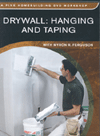
Mirror, mirror on the wall
The face you’ve shown me scares me so
I thought that I could call your bluff
But now the lines are clear enough
Life’s not pretty even though
I’ve tried so hard to make it so
Mornings are such cold distress
How did I ever get into this mess?
The preceding is the beginning of a song performed by Styx that was a hit in the ’80s. It describes the trials and tribulations that many people faced during that time by misusing a certain illegal white substance. Changing a few key words in this stanza redirects the anguish that I felt toward another white powder, a legal one when I was a finisher, and yes, I did use the term Snowblind to describe this condition:
Spackle, spackle on the wall
The catface and scratches you’ve shown me scares me so
I thought that I could sand you off
But now the lines are not clear enough
Drywall’s not pretty even though
I’ve tried so hard to make it so
Sanding in the dark is such cold distress
How did I ever get into this mess?

A wall was painted red to show how well joint compound with white Never- Miss added will cover. If you look, it covered the red entirely.

This is a traditional fi nish job where blue Never-Miss was added to the touchup mud. It is very easy to see the spots that need to be resanded.

Pretty self-explanatory.
Don't Miss Out
During a recent visit to a job site where NM was being used, it was obvious how useful this product is in real world conditions. The day was overcast and shadows were abundant. The finishers had used yellow NM in their final skim coat. Anywhere there was a scratch or a deep joint it showed up as a darker shade of yellow. This effectively acts as a gauge for the finisher to know which spots need more attention. Auto body workers have used this method called “guide coat” for years to prep cars for a show quality paint job. Spots that show up darker need another coat to bring the joint up to finish. Conversely, this guide coat is used to gauge the final sanding. If the entire joint is sanded until it turns white, you know that it has been over sanded. If the joint is dark yellow with light yellow banding around the edges, it has been over sanded on the edges and under sanded in the center. The whole idea behind this product is to be able to speed up the finishing process by only spending time on bad areas.
Once again, self-explanatory.

Skylight before spraying with white Never-Miss.
White Out
Now for the white. Many jobs now call for a Level 5 finish. There are many ways to bring a finish up to Level 5. This subject has been discussed in previous articles in W&C ad nauseam, but I think that NM adds a dimension to joint compound being used for Level Five that has not been available before. Many guys trowel, spray or roll thinned joint compound onto the wall surfaces and then pull a tight trowel over the walls leaving a thin layer of compound, thus technically achieving a Level Five. By adding white NM to the compound two things are achieved. First, color is being added to the compound which helps in the hiding ability of the finish, and second, NM aids in reducing the porosity of the wall surface thus reducing joint flashing and photographing.As with other products meant to be used a certain way, guys are finding new uses for NM in ways specific to their application. Some contractors use NM to track job progress by adding a different color to each coat aiding in identifying the stage of finish they are on. Some add NM to the compound on certain high light areas to reduce the chance of call backs.

Skylight after being sprayed with white Never-Miss.
Once again, I must give my standard disclaimer: I am in no way professionally associated with this product and have not received any compensation to represent it in this column-I just think it’s a great product and think it will save my brothers out there time and money. I will continue to seek out new and exciting ways for Drywall Dogs to do their job in a more cost effective way.
I am proud to report as I pen this column, my oldest son has entered the trenches and is slinging mud just like his old man did for so many years. Life is a circle and perhaps he can teach me a thing or two in the coming years. As always, Rock On!
Remember: mud can be more than just white now!






